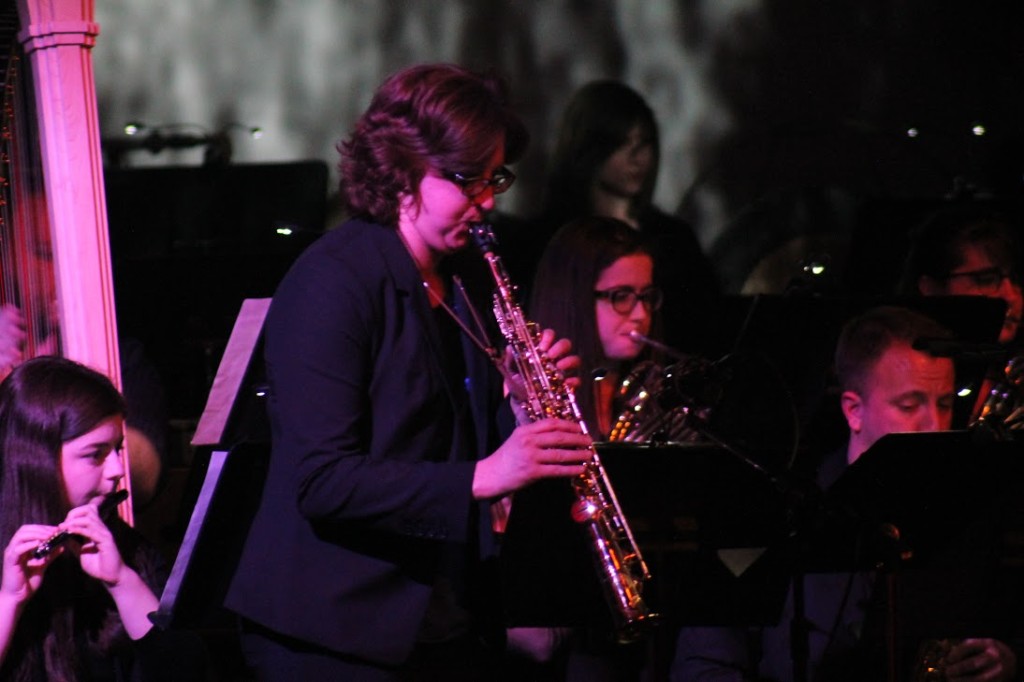By Shayna Innocenti
Staff Writer
Nestled within Kendall Hall Main Stage Theater, the TCNJ Wind Ensemble delivered the electric performance, “Spiritus Mundi,” on Friday, March 4. The group was guided by the visionary David Vickerman, conductor and director of bands at the College.
The spectacular performance featured two new compositions and special guests. The first was Kathleen Mitchell, a principal saxophonist and director of the saxophone ensemble at the College and the Eastern Wind Symphony Youth Band. The youth band was composed of musicians from 14 local high schools.

“At the College, we not only like to show off what we can do, but we also like to support the community, as well,” Vickerman said. “It was a lot of fun putting this collaboration together.”
“Spiritus Mundi,” a term coined by the Irish poet W.B. Yeats, describes how different universal components thrive together harmoniously. This driving force of inspiration perfectly titled the performance, as new age technology played alongside the wind ensemble.
The concert opened with the uplifting medley of “Shepherd’s Hey” (1913), composed by Percy Grainger. Despite having only rehearsed together for the first time 20 minutes before the concert’s start, the TCNJ Wind Ensemble collaborated effortlessly with the Eastern Wind Symphony Youth Band.
Vickerman explained that the original Grainger composition was at a faster pace, reflecting that of an English Morris dance, but that he had to alter the tempo to best suit the ensemble.
“We spent a long time trying to work the gestures of the dance into how we performed the piece,” Vickerman said.
The second piece performed by what Vickerman dubbed as the “Mega Band,” was the somber “Dusk” (2004), composed by Steven Bryant.
Following a brief intermission, the TCNJ Wind Ensemble premiered Christopher Stark’s composition “Velocity Meadows” (2015). The group was accompanied by soprano saxophonist Mitchell for this rendition.
Consisting of five uninterrupted movements, the piece was originally scored for an oboe solo with chamber winds. What made this arrangement truly special was the accompaniment of video manipulation. Created by designer Andrew Lucia, the video of a static dreamscape was projected behind the musicians.
“Stark is very interested in creating landscapes and creating textures,” Vickerman said.
Vickerman also noted that Stark often focuses on having a soloist complement or echo the ensemble, rather than in typical concerto form where the soloist is featured against what the ensemble is doing.
“It is a very organic concerto process, which as someone from California, I appreciate,” Vickerman said.
Mason Bates’s composition, “Observer in the Magellanic Cloud” (2010), was the second new piece for the ensemble. The work was originally scored for a chorus, but with the permission from Bates, Vickerman spent the last year arranging the piece for a wind ensemble.
Vickerman explained that Bates’s composition was inspired by a satellite in deep space. Subsequently, the start of the piece is denoted by a metronome, a sound resembling that of a lone satellite.
“In a lot of ways, this piece embodies our integration of technology — reflecting both the negative and positive aspects,” Vickerman said.
The concert closed with a second Steven Bryant composition, “Ecstatic Waters” (2008). This award-winning piece, inspired by the poetry of Yeats, featured a harmonious blend of the wind ensemble and live electronics.
As denoted by the five movement titles, the piece was like watching a well-oiled machine evolve. It opened with a playful tune that melted away, showcasing the unified power behind the ensemble. But among the chaotic notes was one of the soloists, junior music education major Rachel Kopania, who played the soft-winded ballad that disrupted and disbanded the machine of “Ecstatic Waters.”
Kopania explained that learning to play alongside the electronics was challenging, particularly during her solo as the notes she played were simultaneously being electronically processed and overlaid with pre-recorded sounds.
“There are cue cards for where I have to listen to the electronics and come in with it,” Kopania said. “It was hard to learn, but today, it was just amazing to have it all come together.”
Freshman physics and secondary education dual major Samantha Staskiewicz said that despite her initial concerns about incorporating electronics into the compositions, she was utterly impressed by the ensemble’s performance.
“I have never really heard anything like it before,” Staskiewicz said. “I did band in high school and none of the pieces compared to what I just heard. It was really good.”
The next event the Department of Music will be hosting is on Monday, March 28, entitled East Meets West — where the TCNJ Chorale will be accompanied by choir students from Japan.






